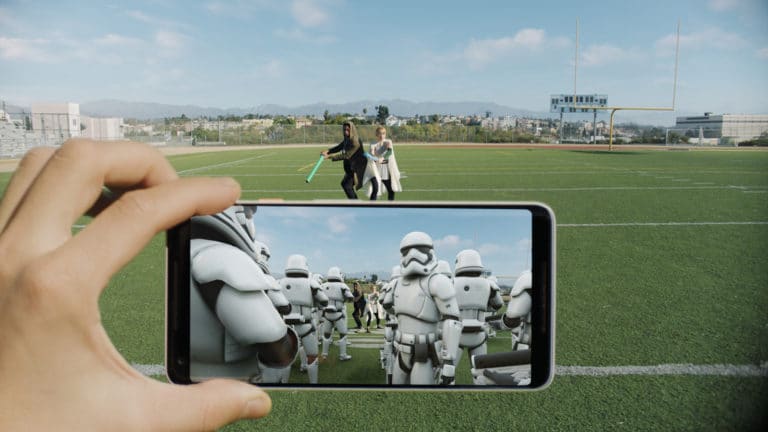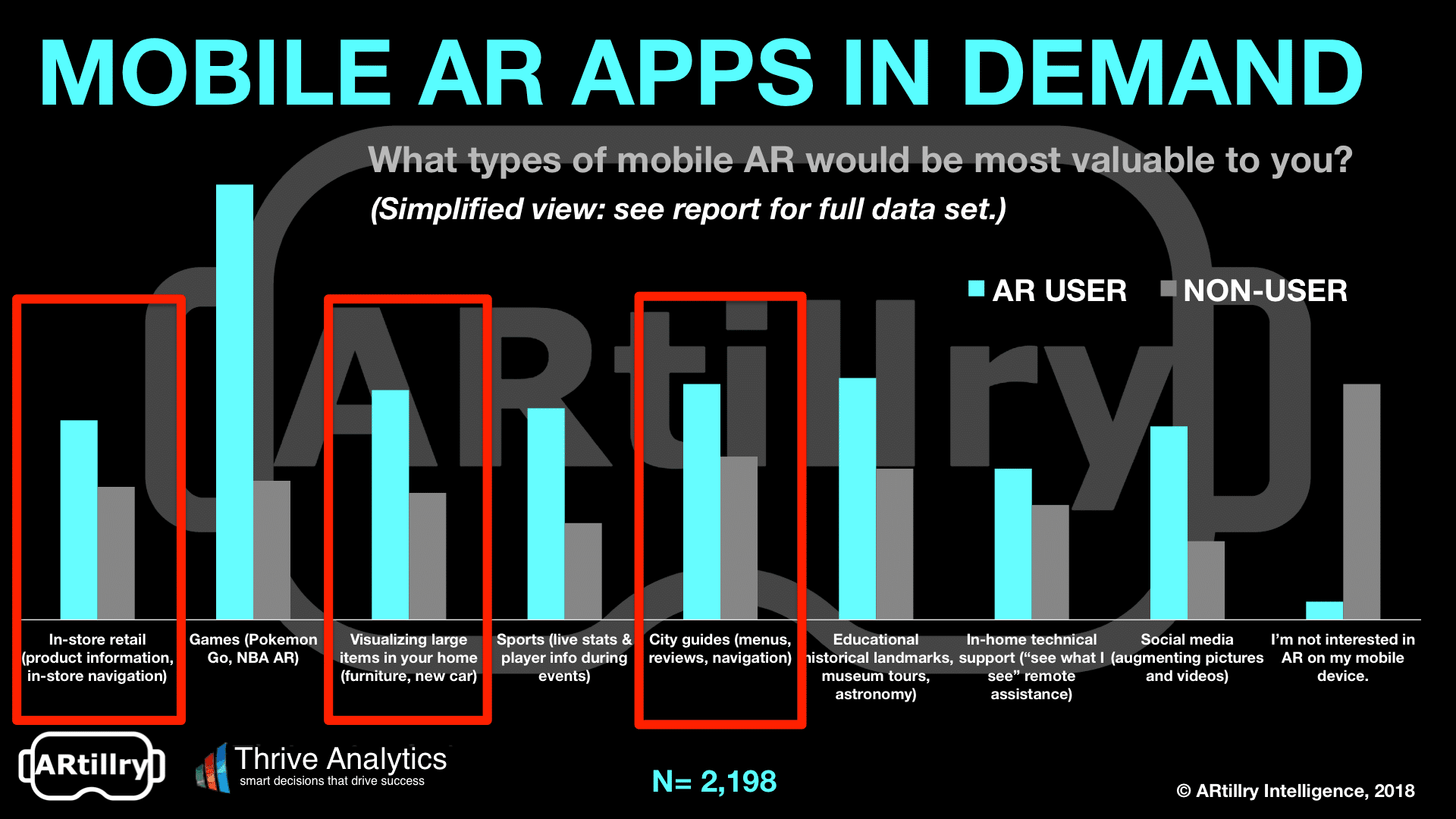
We’ve been vocal that AR apps should “think native.” Build new experiences around AR, rather than tacking AR to existing UX. Also known as “AR-first,” we learned a similar lesson in “mobile-first” app design principles of the last decade.
But it goes deeper than native thinking. There are other best practices and success factors we’ve observed over the past decade. For example the if it ain’t broke test: If a given AR app fills a gap that wasn’t really a pain point for anyone, it could be a solution in search of a problem.
Mobile payments are a historical example. As we predicted years ago (video below), it’s a tough road to ubiquity because paying by cash or credit isn’t broken. These are entrenched behaviors whose proposed replacement was only slightly better. Tap versus swipe… BFD.
Back to XR, we continue to see similar examples of incremental value on things that aren’t broken. In a recent panel discussion, we heard a speaker envision a “no-brainer” AR glasses app that overlays scrolling song lyrics on one’s field of view while at a karaoke bar.
Lyrical overlays are interesting, but are they worth the cost, weight, and fashion crimes of an AR headset in that setting? Moreover, is the current method – the TV or monitor in every Karaoke bar in the world — a pain point for anyone? The answer to both questions is mostly no.
This invokes Visicalc inventor Dan Bricklin’s rule of thumb for disruption. In order to get consumers over the adoption hump, new tech has to be two orders of magnitude (100x) better. That means the old tech has to be really broken… or your mousetrap has to be really stellar.
“You have to be two orders of magnitude — that’s 100 times better — than what came before,” he said at ARiA. “Doing a good-sized spreadsheet by hand took hours, but with an electronic spreadsheet, you can build it in minutes. That’s night & day difference, not just a little better.”

Does AR Make it Better?
For mobile AR, before passing the 100x test — a high bar — we should ask if AR makes something better at all. For example, tabletop AR (battle scene on your coffee table) is cool, but is it better than battle games that let you kick back and point the phone wherever you want?
Put another way, the tabletop aspect makes it novel and native, but crouching and holding up your phone isn’t ergonomic nor conducive to long/repeat sessions. The latter could overpower the former as novelty wears off while gravity doesn’t. So the bar is set high for compelling game play.
Speaking of novelty versus sustained value, there are AR experiences that lack replay-ability. For example, putting storm troopers in your living room is cool, but will anyone do this more than a few times? Stickiness comes from ongoing utility, such as Google’s potential with Lens and VPS.
An augmented fox leading the way on @Google walking maps is another example of #AR making what we already do better. https://t.co/J2uu7us6ek #googleio2018 pic.twitter.com/CYAY4R8O1l
— Charlie Fink (@CharlieFink) June 19, 2018
Going beyond whether something’s better in AR (AR first), another target is if it’s only possible in AR (AR only). This principle drove the killer apps of the iPhone era like Waze, Uber and Foursquare. The common element: they weren’t possible on the previous form factor, the PC.
“You couldn’t make an Uber style app when it was on a PC,” said Escher Reality CEO Ross Finman at TechCrunch Disrupt. “It only made sense after a mobile platform came out. Now it’s about understanding what are the new things you can do with the mobile platform for AR.”
Product visualization apps are good examples of AR-Only: They solve a pain point — personalizing large items — and are only possible in AR. IKEA and BMW exhibit this, and are inherently monetizable as they influence buying decisions and flow into trackable commerce.

Enabling Scale
Related to the question of whether or not AR makes an experience better or worse is the question of if it makes it bigger or smaller. In other words will AR be an engagement driver and growth engine, or will it cause less people to be able to (or want to) use a given app?
Here we’ll play devil’s advocate on a topic that’s become popular in AR circles (including us): Multi-player AR. Having synchronous sessions could indeed open up new capabilities, and use cases for developers to explore. And it could represent the first big killer app(s).
But when chasing that goal, be careful not to prevent scale. Requiring another player in close proximity could be limiting, compared to place-shifted play (think: Words with Friends). So greater compatibility, which AR needs right now, should accommodate remote players or spectators.
“[With] mobile AR, you’re probably somewhere random in the house, at the office or on the move,” said Tony Parisi at AWE. “Requiring someone to be in a specific place is damn inconvenient — unless the whole point is to get you there, such as Niantic’s location-based titles.”
Finally, scale comes from reducing access friction, which Web AR will eventually do. With apps, consider “AR as a feature.” It worked for Snapchat Lenses and Amazon’s AR View. These are essentially AR training wheels: native AR, but delivered in the apps people already use.

Timing is Everything
What everyone’s really waiting for is AR’s killer app, which we could see emerge sometime late next year when AR developers truly gain their native footing. And we believe that will be social and/or gaming oriented and rely on network effect and developments in the AR cloud.
As a historical comparison, it took 2-3 years after the first iPhone before we saw killer apps, such as Waze and Uber around the 2010 timeframe. We could see killer apps in that same elapsed time from last year’s ARkit launch, not to mention the same lesson in native thinking and UX.
“In 2007 when Apple launched the iPhone, most of the apps were flashlights,” said Escher Reality CTO Diana Hu at TechCrunch Disrupt. “People didn’t know what to do yet. And there’s going to be this phase of learning. There’s a genesis of any technology when people need to experiment.”
Meanwhile we’re not without good apps and flashes of innovation. We like what we see from product visualization apps, Google’s VPS and games from smaller players like Happy Giant. Of course usage is half the battle… monetization is another story and should be equally native.
“As far as AR apps and consumer-based products, I think you’re going to see a lot of crap over the next year or two,” said Niantic CTO Phil Keslin during the panel. “But you’ll see some nuggets of creative genuine things that will spark something that will truly be amazing.”
For deeper XR data and intelligence, join ARtillry PRO and subscribe to the free ARtillry Weekly newsletter.
Disclosure: ARtillry has no financial stake in the companies mentioned in this post, nor received payment for its production. Disclosure and ethics policy can be seen here.
Header image credit: Google
